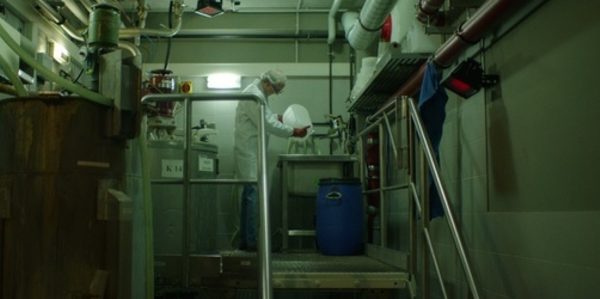INSTANT DREAMS: A Lesson In Science & Nostalgia Trips

Carson Mlnarik is an entertainment journalist and social media coordinator…
Andy Warhol used them in his art.
Susan Sarandon and Geena Davis took one of cinema’s most iconic selfies with one in Thelma & Louise.
Even OutKast encouraged us to shake it like one with “Hey Ya!” in 2002.
There’s something inexplicably romantic, iconic, and immediate about Polaroid photography. Instant Dreams, directed by Willem Baptist, tackles the phenomena head-on, exploring its iconography and practical use in photography, the history that led to its 2008 bankruptcy, and the dedicated group of sentimental scientists working to recreate its original formula.
It’s a fact-filled, camera-flash nostalgia trip that takes its time to develop, like the art form it follows.
A World Within a World
While other instant film processes exist — Fujifilm and Kodak, for example, both have products on market— at the time of the documentary, original Polaroid brand film is in short supply, and mostly expired after production halted in 2008. There’s something irreplaceable about the perfectly square print that started it all, and Instant Dreams bounces between a cast of three characters with varying professions, locations, and lifestyles, who are connected by their appreciation for the idyllic technology — and their desire for it to live on.

Dr. Stephen Herchen is part of the Impossible Project in Germany, working to recreate the complex chemical process that the original Polaroids used. Herschen has left retirement to help rediscover the formula and he’s the perfect man for the job, considering his first gig was at the Polaroid Corporation in 1977. He’s driven by his past relationship with the company and the idea that there’s tens of millions of old Polaroid cameras out there, just waiting for the perfect film formula. The company was originally founded by Edwin Land, an American scientist whose sense of romanticism and preference for aesthetics is comparable to Apple’s Steve Jobs.
The more aesthetic appeal of the technology comes to life through Stefanie Schneider’s story. Schneider is a photographer who gained notoriety for her work with Polaroids, and she takes us to a scenic California desert for a photoshoot. Her dreamy, no-nonsense rejection of most things “modern” help editorialize a driving theme behind the motivation for Polaroids to live on: things move too fast now, and Polaroids have come to represent the halcyon days.
Another piece of the puzzle is Christopher Bonanos, who adds another layer of appreciation to the picture as a journalist and the author of a Polaroid history book. He uses his last stock of Polaroid film to capture moments of his son’s childhood.
“You Don’t Shake It”
Instant Dreams tends to lend its tone to whoever’s story it is telling. When we are in the lab with Dr. Herchen, dramatic music, captivating B-roll of chemical processes and dark room-reminiscent imagery give the story an ominous feel. When we are following Stefanie Schneider, the editing and music give off an almost haunting counter-culture vibe. Then again in Bonanos’ story, we feel a more straight-to-camera documentary approach— we see him in action at a party, entertaining guests on a couch with his camera with schoolboy-like giddiness.

It’s a pivotal moment in showing the separation between the past and present. While vintage Polaroids may be in vogue, the vast majority of the population has settled on iPhone and digital photography, and original formula or not — they’re not going back.
“You don’t shake it,” Bonanos tells one partygoer as they mistakenly shake the developing print. He prattles on to another about the company’s history, and later drives home a point about the social aspect of the camera. There’s almost a ceremony in pressing click and gathering to watch the colors settle. Without negatives or digital files, a Polaroid photo exists entirely on its own and whoever keeps the print, keeps the moment in some form.
While every story is equally entrancing, their connections and transitions occasionally feel a little forced, and the film sometimes breaks it flow to bounce to another scene. To choose between solely focusing on Polaroid enthusiasts or only describing its history would be to cheat its legacy, so editor Albert Markus Jr., has a big job to do in making it all feel cohesive. The overarching energy revolves around the mysterious complex instant film formula and the almost forgotten moment-focused art form, but the heart and sentimentality behind each Polaroid user is equally compelling and sometimes gets overpowered by the dramatic build.

The footage throughout the film is visually stunning. Between the desert, the labs, and the cityscapes that represent the evolving world, the colors, angles and framing feel fresh and creative without feeling overdone or intentionally artsy. While Marc Lizier’s score is heavy-handed, when it hits right, it hits perfectly.
Instant Dreams: Conclusion
What Willem Baptist has crafted is a documentary that feels rooted in both avant garde film and the spirit of Polaroid cameras. There’s no title cards or pie charts telling this story, and you might not know right away whether you’re shifting to another character, seeing B-roll, or quite how you’re supposed to feel seeing the imperfect form of photography juxtaposed against technological wonders. After all, the documentary was presumably filmed on a digital camera and edited in a digital software.
Still, the legacy of Edwin Land and Polaroid cameras deserve a film, and while a looser flow and dramatic flair might not suit everyone’s tastes, the style certainly reflects the photography process that Dr. Herchen calls “a living organism” with “a mind of its own,” and the mix of landscapes and the use of vintage footage, including Polaroid commercials, will leave you with a sweeping view of its impact.
Whether you’re a film geek or just like the aesthetics, you’re sure to find a character whose story interests you, as well as an appreciation for its legacy — at its peak, the company sold near a billion photographs a year — as well as what it still represents in a culture that constantly keeps pushing forward.
Are you a fan of Polaroid cameras and photos ? Is there another vintage technology that has you nostalgic for the past? Let us know in the comments below!
Instant Dreams was released on April 19, 2019 in the US and August 24, 2018 in the UK. For full international release information, click here.
Does content like this matter to you?
Become a Member and support film journalism. Unlock access to all of Film Inquiry`s great articles. Join a community of like-minded readers who are passionate about cinema - get access to our private members Network, give back to independent filmmakers, and more.
Carson Mlnarik is an entertainment journalist and social media coordinator in New York City. He loves movies, Taylor Swift, and iced coffee. For more musings, follow him at twitter.com/carsonmlnarik.













